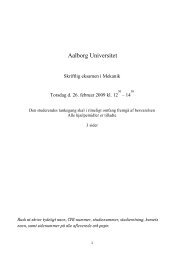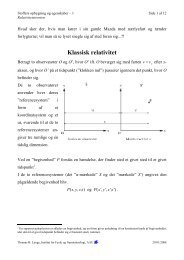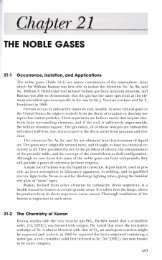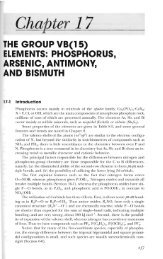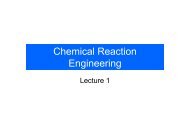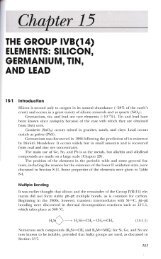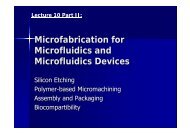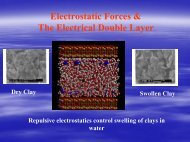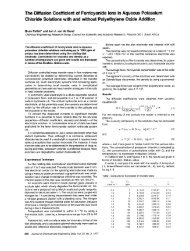The elements of the first transition series.pdf
The elements of the first transition series.pdf
The elements of the first transition series.pdf
- No tags were found...
Create successful ePaper yourself
Turn your PDF publications into a flip-book with our unique Google optimized e-Paper software.
<strong>The</strong> metals <strong>of</strong> <strong>the</strong> <strong>first</strong> <strong>transition</strong><strong>series</strong>
<strong>The</strong> metals <strong>of</strong> <strong>the</strong> <strong>first</strong> <strong>transition</strong><strong>series</strong>• <strong>The</strong> Lower Oxidation States
<strong>The</strong> metals <strong>of</strong> <strong>the</strong> <strong>first</strong> <strong>transition</strong><strong>series</strong>• <strong>The</strong> chemistry <strong>of</strong> <strong>the</strong> metals can be classified on <strong>the</strong>basis <strong>of</strong> this table ;• for example,• <strong>the</strong> d 6 <strong>series</strong> is V ‐I , Cr o , Mn I , Fe II , Co III , and Ni 1v• Comparisons <strong>of</strong> this kind can occasionally emphasizesimilarities in spectra and magnetic properties• differences in properties <strong>of</strong> <strong>the</strong> d n species due todifferences in <strong>the</strong> nature <strong>of</strong> <strong>the</strong> metal its energy levels,and especially <strong>the</strong> charge on <strong>the</strong> ion, <strong>of</strong>ten exceed <strong>the</strong>similarities.
<strong>The</strong> metals <strong>of</strong> <strong>the</strong> <strong>first</strong> <strong>transition</strong><strong>series</strong>• <strong>The</strong> oxidation states less than II.• With <strong>the</strong> exception <strong>of</strong> copper, where copper(I) binarycompounds and complexes and <strong>the</strong> Cu+ ion are known, <strong>the</strong>chemistry <strong>of</strong> <strong>the</strong> I, 0, ‐I, and ‐II formal oxidation states isentirely concerned with:• (a) π‐Acid ligands such as CO, NO, PR3, CN ‐ , and bpy.• (b) Organometallic chemistry in which alkenes, acetylenes,or aromatic systems, such as benzene, are bound to <strong>the</strong>metal.
<strong>The</strong> metals <strong>of</strong> <strong>the</strong> <strong>first</strong> <strong>transition</strong><strong>series</strong>• <strong>The</strong> II oxidation state.• Binary compounds in this state are usually ionic.• <strong>The</strong> metal oxides are basic• have <strong>the</strong> NaCl structure• are <strong>of</strong>ten nonstoichiometric,• particularly for Ti, V, and Fe• <strong>The</strong> aqua ions• [M(H 2 O) 6 ] 2+ , except for <strong>the</strong> unknown Ti 2+ ion, are wellcharacterized in solution and in crystalline solids.
<strong>The</strong> metals <strong>of</strong> <strong>the</strong> <strong>first</strong> <strong>transition</strong><strong>series</strong>• V 2+ , Cr 2+ , and Fe 2+ ions are oxidized by air in acidicsolution
<strong>The</strong> metals <strong>of</strong> <strong>the</strong> <strong>first</strong> <strong>transition</strong><strong>series</strong>• halide hydrates do not contain <strong>the</strong> aqua ion.• VCI 2 . 4H 2 O is trans‐• VCl2 (H2O)4 and MnCI2.4H2O is a polymer with• cis‐MnCI2 (H2O)4 units;• <strong>the</strong> diaqua species <strong>of</strong> Mn, Fe, Co, Ni, and Cu have a linearpolymeric edge‐shared chain structure with trans‐[MCl 4(H 2 O) 2 ] octahedra.• <strong>The</strong> FeCI 2 .6H 2 O compound,contains trans‐FeCl 2 (H 2 O) 4units.• <strong>The</strong> water molecules <strong>of</strong> [M(H 2 O) 6 ] 2+ can be displaced byligands such as• NH 3 , en, EDTA 4‐ , CN ‐ , and acac .
<strong>The</strong> metals <strong>of</strong> <strong>the</strong> <strong>first</strong> <strong>transition</strong><strong>series</strong>• complexes may be• Cationic• neutral• anionic• depending on <strong>the</strong> charge <strong>of</strong> <strong>the</strong> ligands• Addition <strong>of</strong> OH ‐ to <strong>the</strong> M 2+ solutions gives hydroxides• Some can be crystalised• E.g. Fe(OH)2 , Ni(OH)2• With HCO 3 ,<strong>the</strong> carbonates <strong>of</strong> Mn, Fe, Co, Ni, and Cuare precipitated.
<strong>The</strong> metals <strong>of</strong> <strong>the</strong> <strong>first</strong> <strong>transition</strong><strong>series</strong>• <strong>The</strong> III Oxidation State• All <strong>of</strong> <strong>the</strong> <strong>elements</strong> form at least some compounds in thisstate• Exception: Cu• only a few complexes, not stable toward water, are known• <strong>The</strong> fluorides (MF3) and oxides (M20 3) are generally ionic• Chlorides, bromides, and iodides , sulfides and similarcompounds• have considerable covalent character.
<strong>The</strong> metals <strong>of</strong> <strong>the</strong> <strong>first</strong> <strong>transition</strong><strong>series</strong>• <strong>The</strong> <strong>elements</strong> Ti to Co form octahedral ions,[M(H 2 O) 6 J 3 + .• <strong>The</strong> C0 3 + and Mn 3+ ions are reduced by water• Ti 3 + and V 3 + ions are oxidized by air.• In aqueous solution high acidities are required toprevent hydrolysis
<strong>The</strong> metals <strong>of</strong> <strong>the</strong> <strong>first</strong> <strong>transition</strong><strong>series</strong>• Crystalline chlorides <strong>of</strong> V, Fe, and Cr are <strong>of</strong> <strong>the</strong> typetrans‐[VCI 2 (H 2 O)4] + Cl ‐ ∙2H 2 O• <strong>The</strong> alums CsTi(SO4)2.12H2O, or KV(SO4)2.12H2Ocontain <strong>the</strong> hexaaqua ion .• hydrates like Fe(ClO 4 ) 3 ∙10H 2 O.• <strong>The</strong>re are many anionic, cationic, or neutral M Illcomplexes, which are mostly octahedral.• Cr Ill and Co Ill , hundreds <strong>of</strong> octahedral complexes thatare substitutionally inert are known
<strong>The</strong> metals <strong>of</strong> <strong>the</strong> <strong>first</strong> <strong>transition</strong><strong>series</strong>• Representative octahedral complexes are• [TiF 6 ] 3‐• [V(CN) 6 ] 3‐• Cr(acac) 3• [Co(NH 3 ) 6 ] 3+• <strong>The</strong> halides (MX 3 ) act as Lewis acids and formadducts, and• ionic species [VCI4] ‐ ,[CrCI4] ‐
<strong>The</strong> metals <strong>of</strong> <strong>the</strong> <strong>first</strong> <strong>transition</strong><strong>series</strong>• A special feature <strong>of</strong> <strong>the</strong> M 3+ ions is <strong>the</strong> formation <strong>of</strong>basic carboxylates in which an O atom is in <strong>the</strong> center<strong>of</strong> a triangle <strong>of</strong> metal atoms• This oxo‐centered unit• has been proved• for carboxylates <strong>of</strong>• V, Cr, Mn, Fe, Co, Ru, Rh, and Ir.
<strong>The</strong> metals <strong>of</strong> <strong>the</strong> <strong>first</strong> <strong>transition</strong><strong>series</strong>• <strong>The</strong> IV and Higher Oxidation States• <strong>The</strong> IV state is <strong>the</strong> most important state for Ti• main chemistry is that <strong>of</strong>TiO 2 and TiCl4 and derivatives• VCI4, <strong>the</strong> main V IV chemistry is that <strong>of</strong> <strong>the</strong>oxovanadium(IV) or vanadyl ion VO 2+ .• ion can behave like an M 2+ ion,• forms many complexes• cationic, neutral, or anionic, depending on <strong>the</strong> ligand.• For <strong>the</strong> remaining <strong>elements</strong>, <strong>the</strong> IV oxidation state is notvery common or well established except in fluorides,fluorocomplex ions, oxo anions, and a few complexes.
<strong>The</strong> metals <strong>of</strong> <strong>the</strong> <strong>first</strong> <strong>transition</strong><strong>series</strong>• <strong>The</strong> oxidation states V and above are known for• V, Cr, Mn, and Fe• fluorides,• fluorocomplexes• oxo anions• CrF 5• KMn0 4• K 2 FeO 4• All are powerful oxidizing agents.
<strong>The</strong> metals <strong>of</strong> <strong>the</strong> <strong>first</strong> <strong>transition</strong><strong>series</strong>• TITANIUM• Titanium has <strong>the</strong> electronic structure 3d 2 4s 2• <strong>The</strong> energy <strong>of</strong> removal <strong>of</strong> four electrons is so high• that <strong>the</strong> Ti 4+ ion may not exist• titanium(IV) compounds are covalent• some resemblances between Ti 1v and Sn IV and <strong>the</strong>irradii are similar.• TiO 2 (rutile) is isomorphous with SnO 2 (cassiterite)and is similarly yellow when hot
<strong>The</strong> metals <strong>of</strong> <strong>the</strong> <strong>first</strong> <strong>transition</strong><strong>series</strong>• Titanium tetrachloride, like SnCI4 is• a distillable liquid• readily hydrolyzed by water• behaving as a Lewis acid• <strong>The</strong> bromide and iodide,• form crystalline molecular lattices• are isomorphous with <strong>the</strong> corresponding Group IVBhalides
<strong>The</strong> metals <strong>of</strong> <strong>the</strong> <strong>first</strong> <strong>transition</strong><strong>series</strong>• Titanium tetrachloride, a colorless liquid (bp 136°C),• has a pungent odor,• fumes strongly in moist air,• and is vigorously, though not violently, hydrolyzed by water.• Partially hydrolyzed species are formed with a deficit <strong>of</strong>water• or on addition <strong>of</strong> TiCl4 to aqueous HC!.
<strong>The</strong> metals <strong>of</strong> <strong>the</strong> <strong>first</strong> <strong>transition</strong><strong>series</strong>• Titanium oxide has three crystal forms‐• rutile,• anatase,• Brookite• all occur in nature.• <strong>The</strong> dioxide that is used in large quantities as a white pigment inpaints is made by vapor phase oxidation <strong>of</strong> TiCl4 with oxygen.• <strong>The</strong> precipitates obtained by addition <strong>of</strong> OH ‐ to TiN solutions arebest regarded as hydrous TiO 2 , not a true hydroxide.• This material is amphoteric and dissolves in concentrated NaOH.
<strong>The</strong> metals <strong>of</strong> <strong>the</strong> <strong>first</strong> <strong>transition</strong><strong>series</strong>• VANADIUM• Vanadium is widely distributed but <strong>the</strong>re are few concentrateddeposits.• Occurs in petroleum from Venezuela,• is recovered as V 2 O 5 from flue dusts after combustion.• Very pure vanadium is rare,• is quite reactive toward O2, N2, and C at <strong>the</strong> elevated temperatures• Chief commercial use is in alloy steels and cast iron, gives ductility andshock resistance,• commercial production mainly as an iron alloy, ferrovanadium.• Vanadium metal is not attacked by air, alkalis, or nonoxidizing acidso<strong>the</strong>r than HF at room temperature.• It dissolves in HNO 3 , concentrated H2SO4, and aqua regia.
<strong>The</strong> metals <strong>of</strong> <strong>the</strong> <strong>first</strong> <strong>transition</strong><strong>series</strong>• CHROMIUM• <strong>The</strong> chief ore is chromite, FeCr 2 O 4, which is a spinel .It is reduced by C to <strong>the</strong> carbon‐containing alloyferrochromium.• FeCr 2 O 4 +4C Fe∙2Cr+ 4 CO• When pure Cr is required, <strong>the</strong> chromite is <strong>first</strong> treatedwith molten NaOH and O 2 to convert <strong>the</strong> Cr Ill toCrO 42‐.• <strong>The</strong> melt is dissolved in water and sodium dichromateis precipitated. This precipitate is <strong>the</strong>n reduced
<strong>The</strong> metals <strong>of</strong> <strong>the</strong> <strong>first</strong> <strong>transition</strong><strong>series</strong>• Chromium is resistant to corrosion, hence its use as anelectroplated protective coating. It dissolvesfairlyreadily inHCI, H 2 SO 4 ,andHCIO 4 ,but it is passivated byHNO 3 .
<strong>The</strong> metals <strong>of</strong> <strong>the</strong> <strong>first</strong> <strong>transition</strong><strong>series</strong>• Acid solutions <strong>of</strong> dichromate are strong oxidants:• In alkaline solution, <strong>the</strong> chromate ion is much lessoxidizing:
<strong>The</strong> metals <strong>of</strong> <strong>the</strong> <strong>first</strong> <strong>transition</strong><strong>series</strong>• MANGANESE• Manganese is relatively abundant,• occurs in substantial deposits, mainly oxides, hydrousoxides, or <strong>the</strong> carbonate.From <strong>the</strong>m, <strong>the</strong> metal can be obtained by reductionwith AI.• Manganese is quite electropositive, and readilydissolves in dilute, nonoxidizing acids.
<strong>The</strong> metals <strong>of</strong> <strong>the</strong> <strong>first</strong> <strong>transition</strong><strong>series</strong>• <strong>The</strong> most common compound <strong>of</strong> Mn lV is manganesedioxide, a gray to black solid found in nature aspyrolusite• Manganese dioxide is inert to most acids except whenheated, but it does not dissolve to give Mn lV insolution; instead, it functions as an oxidizing agent,<strong>the</strong> exact manner <strong>of</strong> this depending on <strong>the</strong> acid. WithHCI, chlorine is evolved.
<strong>The</strong> metals <strong>of</strong> <strong>the</strong> <strong>first</strong> <strong>transition</strong><strong>series</strong>• Solutions <strong>of</strong> permanganate are intrinsically unstable,decomposing slowly but observably in acid solution.• In basic solution, permanganate is a powerful oxidant.
<strong>The</strong> metals <strong>of</strong> <strong>the</strong> <strong>first</strong> <strong>transition</strong><strong>series</strong>• <strong>The</strong> addition <strong>of</strong>KMn0 4 to concentrated H 2 SO 4 givesstoichiometrically:• <strong>the</strong> dangerous explosive oil, Mn2O7.• This can be extracted into CCl 4 or chlor<strong>of</strong>luorocarbonsin which it is reasonably stable and safe.
<strong>The</strong> metals <strong>of</strong> <strong>the</strong> <strong>first</strong> <strong>transition</strong><strong>series</strong>• IRON• Iron is <strong>the</strong> second most abundant metal, after AI, and<strong>the</strong> fourth most abundant element in <strong>the</strong> earth's crust.<strong>The</strong> core <strong>of</strong> <strong>the</strong> earth is believed to consist mainly <strong>of</strong> Feand Ni.• <strong>The</strong> major ores are• Fe 2 O 3 (hematite),• Fe 3 O4 (magnetite),• FeO(OH) (limonite),• FeCO 3 (siderite).
<strong>The</strong> metals <strong>of</strong> <strong>the</strong> <strong>first</strong> <strong>transition</strong><strong>series</strong>• Pure iron is quite reactive. In moist air it is ra<strong>the</strong>rrapidly oxidized to give a hydrous iron(III) oxide (rust)• <strong>The</strong> metal dissolves readily in dilute mineral acids• With nonoxidizing acids and in <strong>the</strong> absence <strong>of</strong> air, Fellis obtained• Very strongly oxidizing media, such as concentratedHNO 3 or acids containing dichromate, passivate iron• Iron is attacked by hot concentrated NaOH
<strong>The</strong> metals <strong>of</strong> <strong>the</strong> <strong>first</strong> <strong>transition</strong><strong>series</strong>• <strong>The</strong> addition <strong>of</strong> OH‐to Fe 2 + solutions gives <strong>the</strong> palegreen hydroxide, which is very readily oxidized by air togive red‐brown hydrous iron (III) oxide.• <strong>The</strong> iron (II) ion, [Fe(H 2 O) 6 ] 2+ , gives many crystallinesalts.• Mohr's salt, (NH4)2[Fe(H 2 O) 6 ] (SO4)2, is reasonablystable toward air and loss <strong>of</strong> water,• is commonly used to prepare standard solutions <strong>of</strong> Fe 2+for volumetric analysis and as a calibration substancein magnetic measurements.
<strong>The</strong> metals <strong>of</strong> <strong>the</strong> <strong>first</strong> <strong>transition</strong><strong>series</strong>• COBALT• <strong>The</strong> trends toward decreased stability <strong>of</strong> <strong>the</strong> very highoxidation states and <strong>the</strong> increased stability <strong>of</strong> <strong>the</strong> II staterelative to <strong>the</strong> III state• <strong>series</strong> Ti, V, Cr, Mn, and Fe, persist with Co.• <strong>The</strong> highest oxidation state is now IV, and only a few suchcompounds are known. Cobalt(III) is relatively unstable insimple compounds,• Addition <strong>of</strong> OH ‐ to C0 2+ hydroxide,• blue or pink depending on <strong>the</strong> conditions;• weakly amphoteric dissolving in very concentrated OH ‐ togive a blue solution containing <strong>the</strong> [CO(OH)4] 2‐ ion.
<strong>The</strong> metals <strong>of</strong> <strong>the</strong> <strong>first</strong> <strong>transition</strong><strong>series</strong>• Cobalt always occurs in association with Ni and willusually occur also with As.• <strong>The</strong> chief sources <strong>of</strong> Co are "speisses," which areresidues in <strong>the</strong> smelting <strong>of</strong> arsenical ores <strong>of</strong>• Ni, Cu, and Pb.• Cobalt is relatively unreactive,• although it dissolves slowly in dilute mineral acids.
<strong>The</strong> metals <strong>of</strong> <strong>the</strong> <strong>first</strong> <strong>transition</strong><strong>series</strong>• NICKEL• Nickel occurs in combination with• arsenic, antimony, and sulfur e.g. millerite (NiS)garnierite, a magnesium‐nickel silicate• Nickel is also found alloyed with iron in meteors;• <strong>the</strong> interior <strong>of</strong> <strong>the</strong> earth considerable quantities.• <strong>The</strong> ore is roasted in air to give NiO,• Reduced to Ni with C.• Nickel is usually purified by electrodeposition
<strong>The</strong> metals <strong>of</strong> <strong>the</strong> <strong>first</strong> <strong>transition</strong><strong>series</strong>• Nickel is quite resistant to attack by air or water• at ordinary temperatures when compact• electroplated as a protective coating.• It dissolves readily in dilute mineral acids.• <strong>The</strong> metal or high Ni alloys are used to handle F2 and o<strong>the</strong>rcorrosive fluorides.• Nickel absorbs considerable amounts <strong>of</strong> hydrogen when finelydivided and special forms <strong>of</strong>Ni (e.g., Raney nickel) are used forcatalytic reductions.• <strong>The</strong> Chemistry <strong>of</strong> Nickel(II), d 8• <strong>The</strong> binary compounds, such as NiO and NiCI2, need no specialcomment.• Nickel(II) forms a large number <strong>of</strong> complexes with coordinationnumbers six, five, and four.
<strong>The</strong> metals <strong>of</strong> <strong>the</strong> <strong>first</strong> <strong>transition</strong><strong>series</strong>• COPPER• single s electron outside <strong>the</strong> filled 3d shell.• little in common with <strong>the</strong> alkalis• formal stoichiometries in <strong>the</strong> +1 oxidation state.• Filled d shell less effective than noble gas shell in shielding<strong>the</strong> s electron from nuclear charge,• <strong>first</strong> ionization potential <strong>of</strong> Cu is higher than in <strong>the</strong> alkali• d shell electrons involved in metallic bonding,• heat <strong>of</strong> sublimation and melting point <strong>of</strong> copper are alsomuch higher than those <strong>of</strong> <strong>the</strong> alkalis.
<strong>The</strong> metals <strong>of</strong> <strong>the</strong> <strong>first</strong> <strong>transition</strong><strong>series</strong>• Most Cu I compounds are fairly readily oxidized to Cu ll ,but fur<strong>the</strong>r oxidation to Cu III is difficult.• <strong>The</strong>re is a well‐defined aqueous chemistry <strong>of</strong> Cu 2+• large number <strong>of</strong> salts <strong>of</strong> various anions,• many are water soluble,• exist in addition to a wealth <strong>of</strong> complexes.
<strong>The</strong> metals <strong>of</strong> <strong>the</strong> <strong>first</strong> <strong>transition</strong><strong>series</strong>• Binary Compounds• Black crystalline CuO is obtained by pyrolysis <strong>of</strong> <strong>the</strong> nitrateor o<strong>the</strong>r oxo salts; above 800 °c it decomposes to Cu 2 O.• hydroxide is obtained as a blue bulky precipitate on addition<strong>of</strong> NaOH to Cu 2+ solutions• soluble in strong acids• concentrated NaOH• deep blue anions• halides are <strong>the</strong> yellow chloride and <strong>the</strong> almost black bromide• infinite parallel bands <strong>of</strong> square CuX4 units sharing edges
<strong>The</strong> metals <strong>of</strong> <strong>the</strong> <strong>first</strong> <strong>transition</strong><strong>series</strong>• Catalytic Properties <strong>of</strong> Copper Compounds• Copper compounds catalyze reactions,• heterogeneously, homogeneously, in <strong>the</strong> vapor phase, in organicsolvents, and in aqueous solutions.• Many <strong>of</strong> <strong>the</strong>se reactions, particularly if in aqueous solutions,involve oxidation‐reduction systems• and CU I ‐CU II redox cycle.• Molecular oxygen oxidant, e.g. copper‐catalyzed oxidations <strong>of</strong>ascorbic acid• Cu + + O 2 =CuO 2+• CuO 2+ + H + = Cu 2 + + HO 2• CU + + HO 2 = Cu 2+ + HO 2‐• H + + HO 2‐ = H 2 O 2



